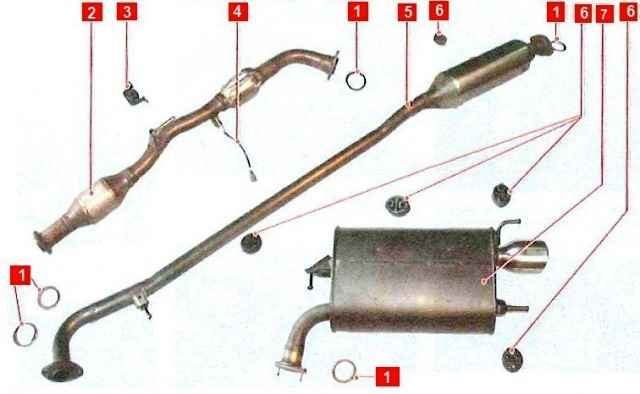Exhaust gases are removed from the engine through a catolector (exhaust manifold combined with a converter), an additional converter built into the exhaust pipe, an additional and main muffler

The main (control) oxygen concentration sensor is installed on the collector, and a diagnostic sensor is installed on the exhaust pipe (after the converter).
A sealing metal-reinforced gasket 1 is installed between the flanges of the cylinder head and the collector 3.

Flange connections of the collector with the exhaust pipe, the exhaust pipe with an additional silencer and the additional silencer with the main silencer are sealed with metal-reinforced rings 1
The elements of the system are suspended from the body on six rubber cushions.
Moreover, the pillow 3 of the suspension of the exhaust pipe and the pillows 5 of the suspension of the additional and main mufflers have a different shape.
To protect the base of the body and the fuel tank from heating by the elements of the exhaust system, thermal screens made of heat-resistant non-woven material are installed above the exhaust pipe, additional and main mufflers.
In addition, an additional steel thermal screen 4 is installed above the collector.
The exhaust system does not require special maintenance.
It is enough to periodically check the reliability of the tightening of the threaded connections and the integrity of the suspension pads.
In case of damage to the elements of the system, through corrosion or burnout, they are replaced as an assembly, since the extinguishers together with the pipes are non-separable units.
Check the exhaust system periodically.
If there is an increased noise level from the exhaust system, check its tightness. To do this, start the engine and inspect the entire system
By running your hand over the places of possible leakage, without touching the knots, you will immediately feel the leakage of gases.
If necessary, replace rusted and burnt parts.
Before repairing the exhaust system, let it cool down as it gets hot while the engine is running
If it is impossible to replace a defective unit with a new one, you can temporarily restore its performance by applying a metal patch to the damaged area and securing it with clamps or wire
It is recommended to place a sheet of asbestos under the patch.
In addition, auto parts stores sell special kits for rebuilding exhaust system components, with which you can temporarily repair damage to the system in order to get to a car service or garage











